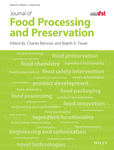Effect of severing skeletal muscle at different stage of rigor on the quality of pacific white shrimp (Litopenaeus vannamei)
Abstract
Effect of severing skeletal muscle (by beheading) at different stages of rigor on the quality of pacific white shrimp (Litopenaeus vannamei) during ice storage was assessed by physical, chemical, and sensory evaluation. Shrimps were divided into three lots, one lot (T1) beheaded immediately after killing, 2nd (T2), and 3rd (T3) lots were beheaded after 5 h and 35 h post-mortem corresponding to pre-rigor, in-rigor, and post-rigor stages, respectively. There was an increase in the moisture content in all the treatments during the storage. PV, TVB-N, and TMA-N values also increased with the storage time, though the values of all these parameters were well within the acceptable limits. Total protein, Sarcoplasmic protein, NPN, and water holding capacity showed a decreasing trend in all the treatments. Hardness, springiness, cohesiveness and chewiness values did not differ significantly (p ≤ .05) between the treatments. L* value showed a decreasing trend throughout the study. Information provided in this study can serve as baseline for postharvest preservative treatments of crustacea products.
Practical applications
This work examined the effect of the time of beheading on the quality of shrimps in ice storage. No work ever looked at the possibility of whether the quality of shrimp varies if its skeletal muscle is severed (by beheading) during pre-rigor, on-rigor, and post-rigor stages. The ice storage studies of three lots demonstrated similar deterioration of quality, without significant differences among the lots. This strongly suggests that the transportation of the whole shrimps to a processing factory at a distant site provides no comparative advantage in terms of quality.




